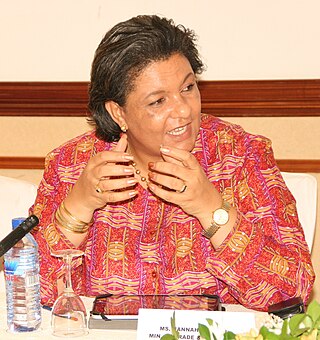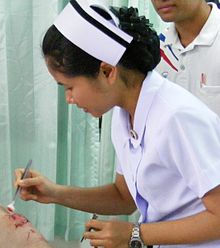
Violence against women (VAW), also known as gender-based violence and sexual and gender-based violence (SGBV), is violent acts primarily or exclusively committed by men or boys against women or girls. Such violence is often considered a form of hate crime, committed against women or girls specifically because they are female, and can take many forms.
Equality Now is a non-governmental organization founded in 1992 to advocate for the protection and promotion of the human rights of women and girls. Equality Now works through public policy channels to create a just world for women and girls. Through a combination of regional partnerships, community mobilization and legal advocacy the organization works to encourage governments to adopt, improve and enforce laws that protect and promote women and girls' rights around the world.

The status of women in Ghana and their roles in Ghanaian society has changed over the past few decades. There has been a slow increase in the political participation of Ghanaian women throughout history. Women are given equal rights under the Constitution of Ghana, yet disparities in education, employment, and health for women remain prevalent. Additionally, women have much less access to resources than men in Ghana do. Ghanaian women in rural and urban areas face slightly different challenges. Throughout Ghana, female-headed households are increasing.

Women in Kyrgyzstan traditionally had assigned roles, although only the religious elite sequestered women as was done in other Muslim societies. Rural inhabitants continue the traditional Siberian tribal practice of bride kidnapping. Bride kidnapping, known as ala kachuu, girls as young as 12 years old are kidnapped for forced marriage, by being captured and carried away by groups of men or even relatives who, through violence or deception, take the girl to the abductor's family who forces and coerces the young woman to accept the illegal marriage. In most cases, the young woman is raped immediately in the name of marriage.[8]

The roles of women in Lebanon have evolved throughout history. The legal status of women transformed over the 20th century, but traditional patriarchal norms and conservative versions of Islamic law continue to influence women's rights in Lebanon.

The status of women in Nepal has varied throughout history. In the early 1990s, like in some other Asian countries, women in Nepal were generally subordinate to men in virtually every aspect of life. Historically, Nepal has been a predominantly patriarchal society where women are generally subordinate to men. Men were considered to be the leader of the family and superior to women. Also, social norms and values were biased in favor of men. This strong bias in favor of sons in society meant that daughters were discriminated against from birth and did not have equal opportunities to achieve all aspects of development. Daughters were deprived of many privileges, including rights, education, healthcare, parental property rights, social status, last rites of dead parents, and were thought to be other's property and liabilities. In the past century, there has been a dramatic positive change in the role and status of women in Nepal, reducing gender inequality. While the 1990 Constitution guaranteed fundamental rights to all citizens without discrimination on the basis of ethnicity, caste, religion, or sex, the modernization of society, along with increased education of the general population, have also played an important role in promoting gender equality. The roles of women have changed in various ways in the modern Nepalese society.
Gender inequality in India refers to health, education, economic and political inequalities between men and women in India. Various international gender inequality indices rank India differently on each of these factors, as well as on a composite basis, and these indices are controversial.

Women in Singapore, particularly those who have joined Singapore's workforce, are faced with balancing their traditional and modern-day roles in Singaporean society and economy. According to the book The Three Paradoxes: Working Women in Singapore written by Jean Lee S.K., Kathleen Campbell, and Audrey Chia, there are "three paradoxes" confronting and challenging the career women of Singapore. Firstly, Singapore's society expects women to become creative and prolific corporate workers who are also expected to play the role of traditional women in the household, particularly as wife and mother. Secondly, Singaporean women are confronted by the "conflict between work and family" resulting from their becoming members of the working population. Thirdly, Singapore's female managers are still fewer in number despite their rising educational level and attainments when compared to male managers.

Women in Malaysia receive support from the Malaysian government concerning their rights to advance, to make decisions, to health, education and social welfare, and to the removal of legal obstacles. The Malaysian government has ensured these factors through the establishment of Ministry of National Unity and Social Development in 1997. This was followed by the formation of the Women's Affairs Ministry in 2001 to recognise the roles and contributions of Malaysian women.
Women in Cambodia, due to the influence of the dominant Khmer culture, are traditionally expected to be modest and soft-spoken. They are to be well-mannered, industrious, and hold a sense of belonging to the household. It is expected that they act as the family's caregivers and caretakers, financial administrators, and serve as the "preserver of the home". As financial administrators, women can be identified as having household authority at the familial level. Khmer women are expected to maintain virginity until marriage, become faithful wives, and act as advisors to their husbands. Women in Cambodia have also be known as “light” walkers-- "light" walking and refinement of the Khmer women is further described as being "quiet in […] movements that one cannot hear the sound of their silk skirt rustling".
Feminism in Thailand is perpetuated by many of the same traditional feminist theory foundations, though Thai feminism is facilitated through a medium of social movement activist groups within Thailand's illiberal democracy. The Thai State claims to function as a civil society with an intersectionality between gender inequality and activism in its political spheres.
The social and economic changes in Thailand in the past decades have important implications for the quality and quantity of labor. The economic and non-economic roles of women in Thailand can be traced back several hundred years in Thai history, when there were traditional discriminatory attitudes towards women in the culture of Thailand. The transformation of Thailand's social and economic structure since the 1960s led to the gender disparities in Thai society. Recently, the position of Thai women in the labor market has improved a lot in comparison to the past as a result of modernization. In 2011, Thailand ranked 69th out of 143 countries in the Gender Inequality Index. In labor economics, gender inequality is widely discussed in terms of concepts of sex segregation and employment discrimination. Thai government and non-governmental organizations have put forth many policies and programs to address gender inequalities in the last few decades.

Gender inequality can be found in various areas of Salvadoran life such as employment, health, education, political participation, and family life. Although women in El Salvador enjoy equal protection under the law, they are often at a disadvantage relative to their male counterparts. In the area of politics, women have the same rights as men, but the percentage of women in office compared to men is low. Though much progress has been made since the Salvadoran Civil War ended in 1992, women in El Salvador still face gender inequality.
Prosecution of gender-targeted crimes is the legal proceedings to prosecute crimes such as rape and domestic violence. The earliest documented prosecution of gender-based/targeted crimes is from 1474 when Sir Peter von Hagenbach was convicted for rapes committed by his troops. However, the trial was only successful in indicting Sir von Hagenbach with the charge of rape because the war in which the rapes occurred was "undeclared" and thus the rapes were considered illegal only because of this. Gender-targeted crimes continued to be prosecuted, but it was not until after World War II when an international criminal tribunal – the International Military Tribunal for the Far East – were officers charged for being responsible of the gender-targeted crimes and other crimes against humanity. Despite the various rape charges, the Charter of the Tokyo Tribunal did not make references to rape, and rape was considered as subordinate to other war crimes. This is also the situation for other tribunals that followed, but with the establishments of the International Criminal Tribunal for the former Yugoslavia (ICTY) and the International Criminal Tribunal for Rwanda (ICTR), there was more attention to the prosecution of gender-targeted crimes with each of the statutes explicitly referring to rape and other forms of gender-targeted violence.
The evolution and history of women in Asia coincide with the evolution and history of Asian continent itself. They also correspond with the cultures that developed within the region. Asian women can be categorically grouped as women from the Asian subregions of Central Asia, East Asia, North Asia, South Asia, Southeast Asia, and Western Asia.

The term 'political participation' has a very wide meaning. It is not only related to 'Right to Vote', but simultaneously relates to participation in: decision-making process, political activism, political consciousness, etc. Women in India participate in voting, run for public offices and political parties at lower levels more than men. Political activism and voting are the strongest areas of women's political participation. To combat gender inequality in politics, the Indian Government has instituted reservations for seats in local governments.
Gender inequality has been improving a lot in Bangladesh, inequalities in areas such as education and employment remain ongoing problems so women have little political freedom. In 2015, Bangladesh was ranked 139 out of 187 countries on the Human Development Index and 47 out 144 countries surveyed on the Gender Inequality Index in 2017. Many of the inequalities are result of extreme poverty and traditional gender norms centred on a patrilineal and patriarchal kinship system in rural areas.
Gender equality is the notion that each gender should receive equal treatment in all aspects of life, and that one should not be discriminated based on their sex. Gender equality is a human right, which is recognised under the United Nations Universal Declaration of Human Rights.
Gender inequality in Nepal refers to disparities and inequalities between men and women in Nepal, a landlocked country in South Asia. Gender inequality is defined as unequal treatment and opportunities due to perceived differences based solely on issues of gender. Gender inequality is a major barrier for human development worldwide as gender is a determinant for the basis of discrimination in various spheres such as health, education, political representation, and labor markets. Although Nepal is modernizing and gender roles are changing, the traditionally patriarchal society creates systematic barriers to gender equality.
Association for the Promotion of the Status of Women (APSW) is a women's organization in Thailand, founded in 1970.












